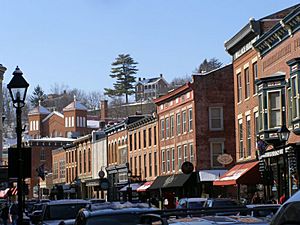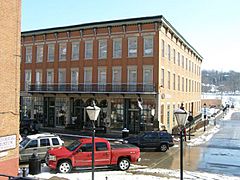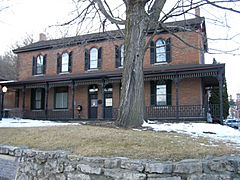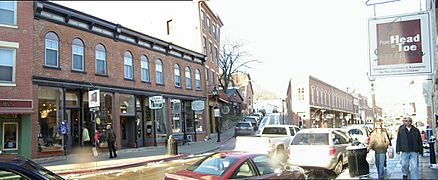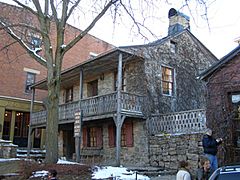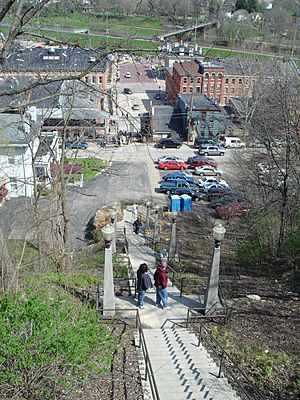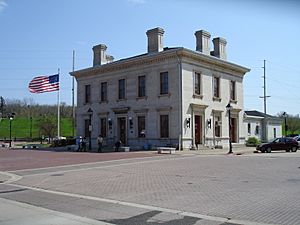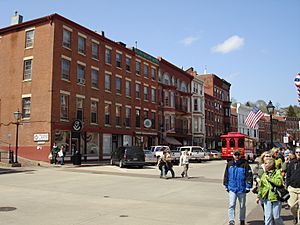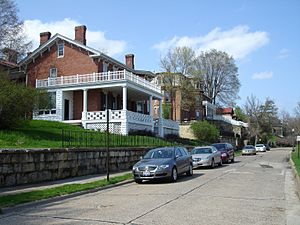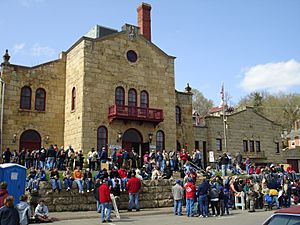Galena Historic District facts for kids
|
Galena Historic District
|
|
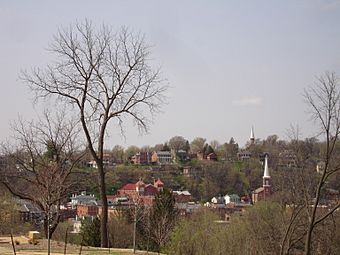
The heart of the district, viewed from U.S. Grant's Home
|
|
| Lua error in Module:Location_map at line 420: attempt to index field 'wikibase' (a nil value). | |
| Location | Roughly bounded by Davis Cr., 4th, 5th, Adams, Field, Wann, N. Dodge, Fulton, N. Hickory, Hill, Ridge & Spring Sts., Galena, Illinois |
|---|---|
| Built | c. 1838–1900 |
| Architectural style | Greek Revival, Late Victorian |
| NRHP reference No. | 69000056 (original) 13000854 (increase) 13000854 (decrease) |
Quick facts for kids Significant dates |
|
| Added to NRHP | October 18, 1969 |
| Boundary increase | October 23, 2013 |
| Boundary decrease | October 23, 2013 |
The Galena Historic District is a special area in Galena, Illinois, USA, that has been kept just as it was a long time ago. It covers about 85% of the city and includes over 800 old buildings.
The main part of downtown Galena has three levels: Main Street, Bench Street, and Prospect Street. Famous homes like the Ulysses S. Grant Home and the Elihu Benjamin Washburne House are found here. This historic district was added to the U.S. National Register of Historic Places in 1969. This means it's officially recognized as an important place to protect.
Contents
What is the Galena Historic District?
The Galena Historic District includes most of the city of Galena. It covers any area, building, or object within the "original city" and all parts added before December 31, 1859. This helps protect the old look and feel of the town.
A Look Back at Galena's History
Galena's unique look was shaped by many fires in the 1850s. After these fires, the city decided that new buildings could not be made of wood. This is why downtown Galena is mostly built from strong materials like brick and stone.
Galena grew quickly in its early days because of the lead mining industry nearby. By the 1830s, Galena had more people than Chicago! Many thought Galena would become the most important city in the Midwest.
However, Galena started to decline in the 1860s. Railroads became the main way to transport goods, replacing rivers. Also, the price of lead dropped.
By the 1880s, Galena was no longer as important. Other river towns like Dubuque, Iowa grew bigger. Major railroads also chose other locations. The Galena River became harder to travel on, and floods, like a big one in 1937, ended Galena's busiest times.
Galena continued to decline until the 1950s. Many downtown buildings were old and empty. But then, people started to care about saving old places. Galena was one of the first cities in Illinois to pass a law to protect its historic buildings in 1965. Four years later, the Galena Historic District was added to the National Register of Historic Places.
Buildings in the District
General Layout of Downtown Galena
The Galena Historic District has over 1,000 buildings built before 1900. Downtown Galena is set up in three parallel levels. Main Street is closest to the river. Higher up are Bench Street and then Prospect Street.
Main Street is the main shopping area. It has buildings that are two, three, or four stories tall. Most buildings on Main Street are made of red brick. They show the simple Federal style or commercial style from the 1840s.
On Bench Street, you'll find public buildings and churches. Their tall steeples can be seen from far away. Behind Bench Street, on a wooded hill, is Prospect Street. This street is mostly for homes, except for a large old high school with a clock tower. Many of the private homes here are from Galena's early days. It's amazing how many 19th-century homes are still standing in this area!
Important Individual Buildings

Inside the Galena Historic District, three buildings are so important they are listed on the National Register of Historic Places by themselves. These are the Ulysses S. Grant Home (a National Historic Landmark), the Elihu Benjamin Washburne House, and the Old Market House. Many other old buildings from Galena's early history are also part of the district.
The DeSoto House Hotel on Main Street opened in 1855. It is said to be the oldest hotel still operating in Illinois. Many important people stayed there, like Theodore Roosevelt and Ralph Waldo Emerson. Abraham Lincoln even gave a speech from its balcony! Today, the hotel has 55 rooms, two dining rooms, and a tavern.
Just off Main Street is the historic Galena Customs House and U.S. Post Office. This building is a great example of Federal style architecture. It was built in 1858 and first served as the Customs House. Now, it's the U.S. Post Office.
Even among the public buildings on Bench Street, you can find beautiful old mansions. The John Dowling House is one example. It was built in the Classical Revival style in 1847. It stands on the land where a stockade (a fort) was built during the Black Hawk War.
Architectural Styles
The buildings in the Galena Historic District show many different architectural styles from different time periods. You can see simple commercial buildings from the 1820s, as well as Greek Revival, Italianate, Gothic Revival, and later Victorian style buildings. Galena is known for having some of the best Greek Revival architecture in the United States.
The buildings along Main Street look very unified. Main Street curves, following the path of the Galena River. This curve makes the street feel special and is rare in American towns. Beyond Main Street, on the bluffs facing Prospect Street, are huge mansions built between 1840 and 1890. These homes were built by mine owners and steamboat captains. They show a mix of styles, but each one clearly represents its time period.
Because of its unique old buildings, Galena has been called names like the "outdoor museum of the Victorian Midwest" or "the town that time forgot." Some people think the best architecture is on Main Street, while others prefer the grand 19th-century mansions on the surrounding bluffs.
Why Galena is Historically Important
In 1858, Galena had 14,000 people before it started to decline. However, many of its buildings survived, even if they became run down. Galena was very important in the early growth of the Upper Midwest. Today, the town still feels like it did in the 1800s. Walking through Galena's streets, especially in the quiet morning, feels like stepping back in time. Galena still has the charm and grace of its prosperous past, which has disappeared in many other American towns due to industrialization.
The Galena Historic District was added to the U.S. National Register of Historic Places on October 18, 1969. It was listed because of its importance in areas like agriculture, mining, art, and military history.
Galena as a Tourist Spot
Galena attracts more than one million visitors every year! The exact number changes, but it's always a lot. For example, The New York Times and Smithsonian magazine both reported over a million visitors in the early 2000s. The Chicago Tribune estimated 1.3 to 1.4 million visitors annually.
The historic district is full of shops and businesses that cater to tourists. You can find many bed and breakfast inns, over a dozen art galleries, and lots of restaurants and taverns downtown.
After the Galena Historic District was listed on the National Register, the area began to change. At first, many antique stores opened. Now, these have mostly been replaced by more restaurants and retail shops, many of which are for tourists. This change has had mixed reactions from people who live and work in Galena. Some residents like the shift to more restaurants and shops, while others miss the old antique stores and worry about rising rent costs.


